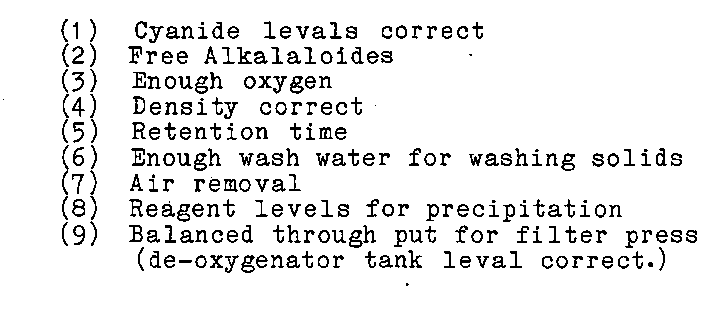The Cyanidation Process or CYANIDE LEACHING is ‘most notably used in the recovery of gold. Safety and environmental concerns are of prime importance in the operation of a cyanidation plant. As we get farther into this type of recovery you will see why.
 The preparation of the ore for processing is similar to flotation. The ore must be ground to a specific size before it can be treated. But instead of being floated away from the rock, it is dissolved by the cyanide to form a liquid solution. As I mentioned for this process to work the ore is ground to a specific size, at a predetermined density. It is then put into a large holding area where the cyanide is added. To have the desired reaction take place, there must be enough cyanide present to dissolve all of the mineral. To have the necessary chemical reaction take place, oxygen must be added. To accomplish this, air is bubbled through the solution of cyanide and slurry. As you learned earlier in the flotation section, Cyanide is a very potent poison. To ensure that the slurry doesn’t become acidic an alkaloid is added to the cyanidation tanks. Again the common reagent that is used for this is lime. A common Cyanidation Process for Gold or called CIL and CIP.
The preparation of the ore for processing is similar to flotation. The ore must be ground to a specific size before it can be treated. But instead of being floated away from the rock, it is dissolved by the cyanide to form a liquid solution. As I mentioned for this process to work the ore is ground to a specific size, at a predetermined density. It is then put into a large holding area where the cyanide is added. To have the desired reaction take place, there must be enough cyanide present to dissolve all of the mineral. To have the necessary chemical reaction take place, oxygen must be added. To accomplish this, air is bubbled through the solution of cyanide and slurry. As you learned earlier in the flotation section, Cyanide is a very potent poison. To ensure that the slurry doesn’t become acidic an alkaloid is added to the cyanidation tanks. Again the common reagent that is used for this is lime. A common Cyanidation Process for Gold or called CIL and CIP.
The amount of these two reagents in the slurry is very important, without enough cyanide to consume all of the valuable mineral there will be losses. Without enough lime a condition may developed that could potentially be very hazardous to the workers well-being. To ensure that there is enough lime and cyanide being added to the leach circuit a TITRATION must be done. A titration is simply a method of determining the amount of reagent in the slurry. There are chemicals that will react to each of these two reagents in a predetermined manner. By measuring the amount of chemical that is used to obtain that reaction it is possible to determine the amount of reagent that is in the slurry. The use of the titration method of determining the alkalinity of the slurry is desirable over a simple P.H. meter reading. A P.H. reading while designed to state when a solution is alkaline will also mistakenly register on HYDROXIDES. The operator will then mistake this for an Alkalinity reading. The meter cannot indicate which’ is which. The titration reading will indicate the amount of actual lime that is not consumed by acid. This will ensure that there is enough free lime to react with and neutralize any acid molecules that the lime comes into contact with.
The retention time here is as critical as it is in the flotation circuit. If the cyanide doesn’t sit long enough in the solution it will not dissolve all of the gold. If it is in solution to long, the solution will POOL by having other minerals dissolved into it. Soon after that happens the valuable mineral will begin PRECIPITATING OUT. As planned precipitation takes place under controlled conditions later in the process, it will be explained once we have finished discussing the separation of the gold bearing cyanide liquid from the rock.
Before we leave cyanidation lets go over those variables that the operator will have to watch:
Determine Lime Consumption
Before making up a bottle charge on an unknown ore it is necessary to ascertain the probable alkali consumption. For this purpose weigh up 4 lots of pulp of about 200 grams each, and add water at a ratio of 3:1, numbering the bottles 1, 2, 3, and 4. Then add slaked lime powder at the rate of 5 lb. per ton of ore to No. 1,10 lb. to No. 2, 15 lb. to No 3, and 20 lb. to No 4, and agitate for from 6 to 12 hours. At the end of the period filter off some of the liquor from each and test for alkalinity. The quantity found in solution will furnish an estimate of how much lime will be needed for making up the cyanide extraction test. Generally, a residual strength of 0.05% CaO will indicate a suitable quantity of lime for an all-gold ore, and 0.1% for a silver or silver-gold ore. To obtain the amount of lime needed in terms of pure calcium oxide (CaO) the strength of the lime used for the test maybe ascertained closely by putting one gram in a litre of distilled water, and agitating in a bottle for 8 or 10 hours. The water is then filtered and titrated for alkalinity and the amount of CaO dissolved from 1 gram of lime calculated in terms of percentage. A more accurate method of determining available alkalinity of lime.

